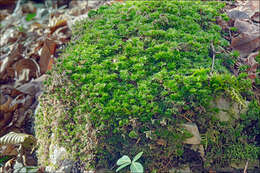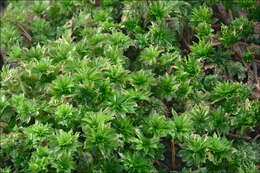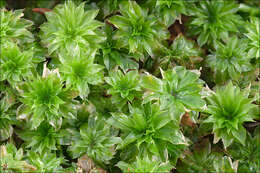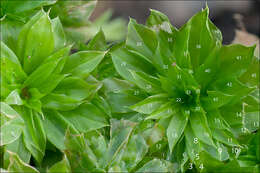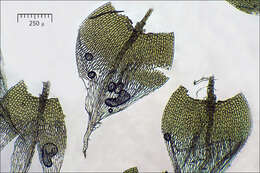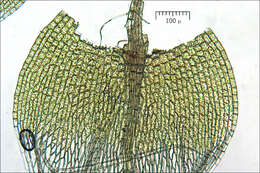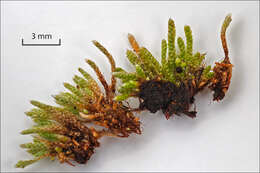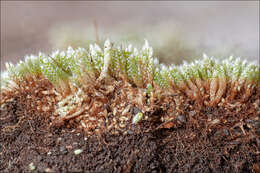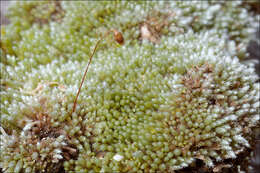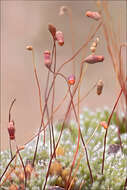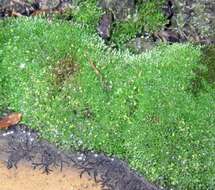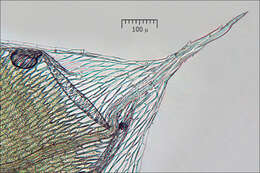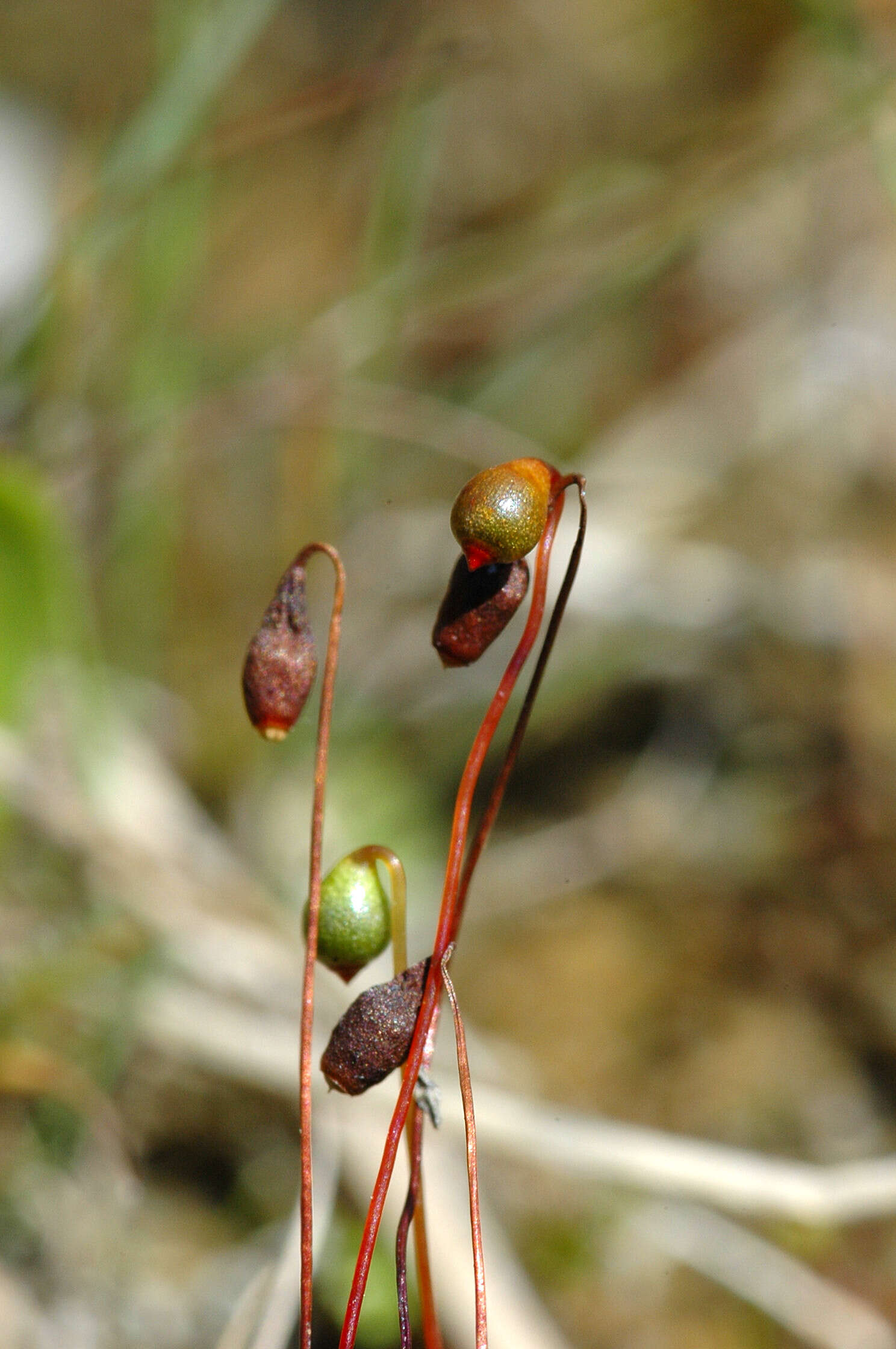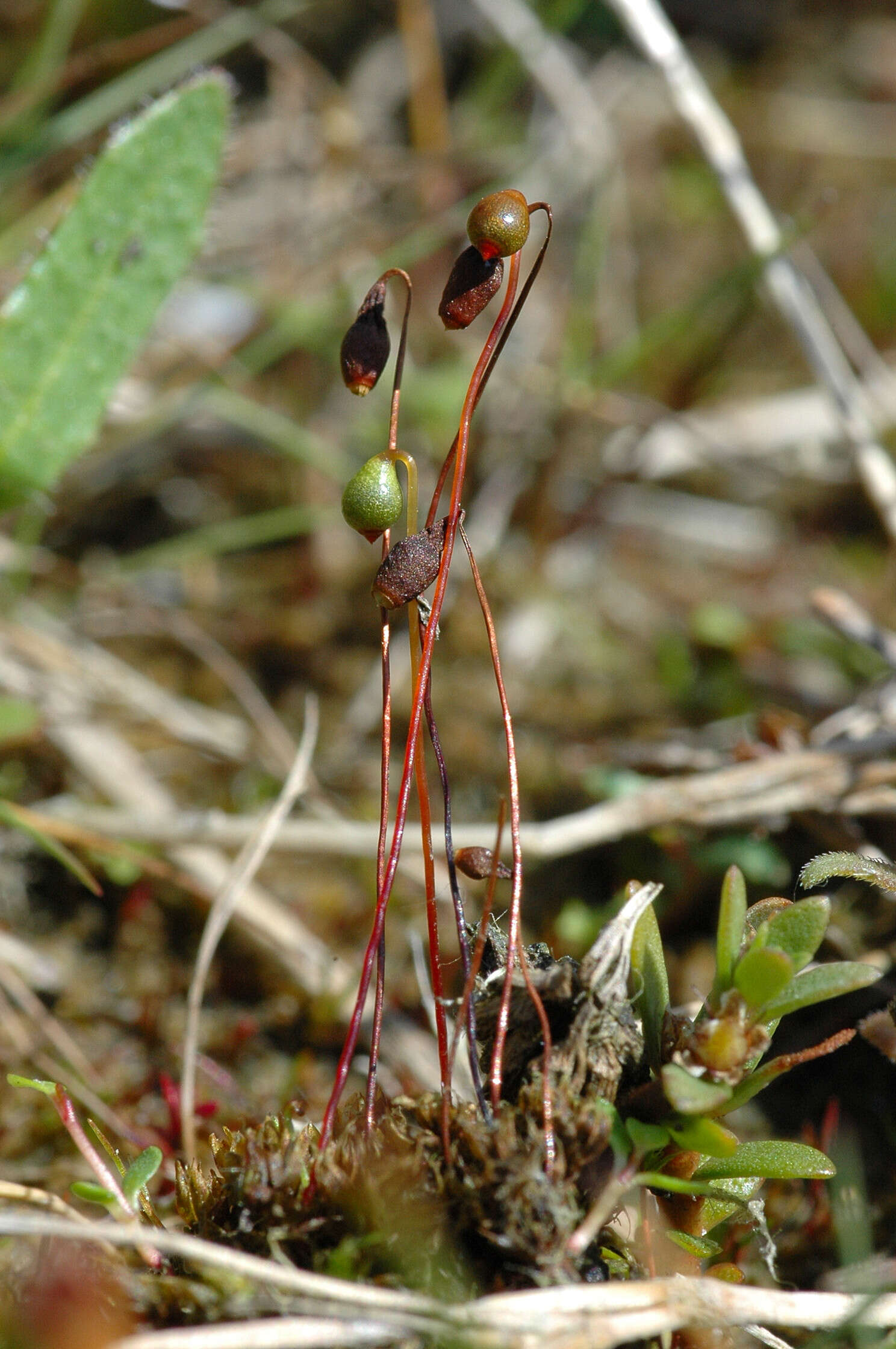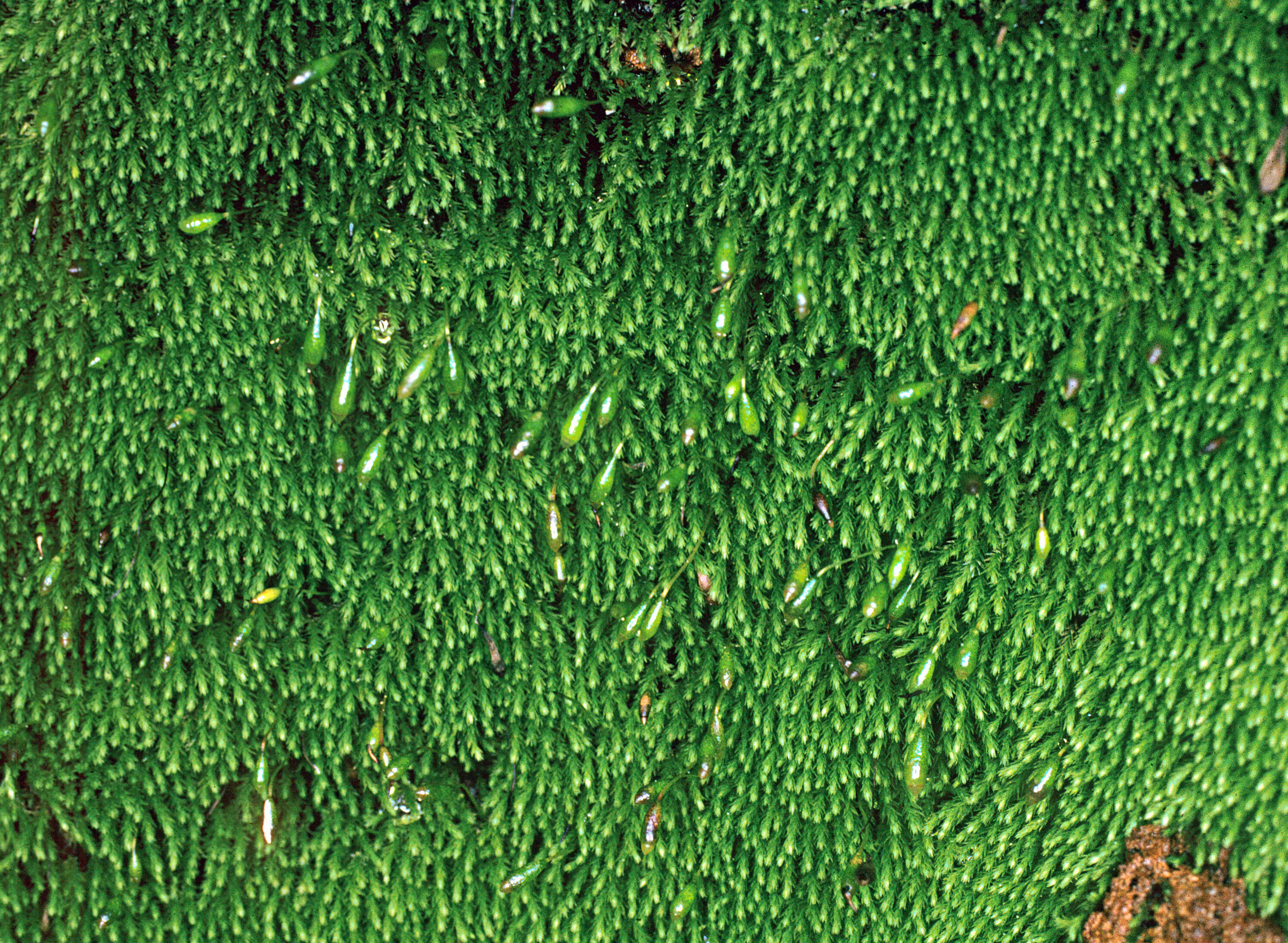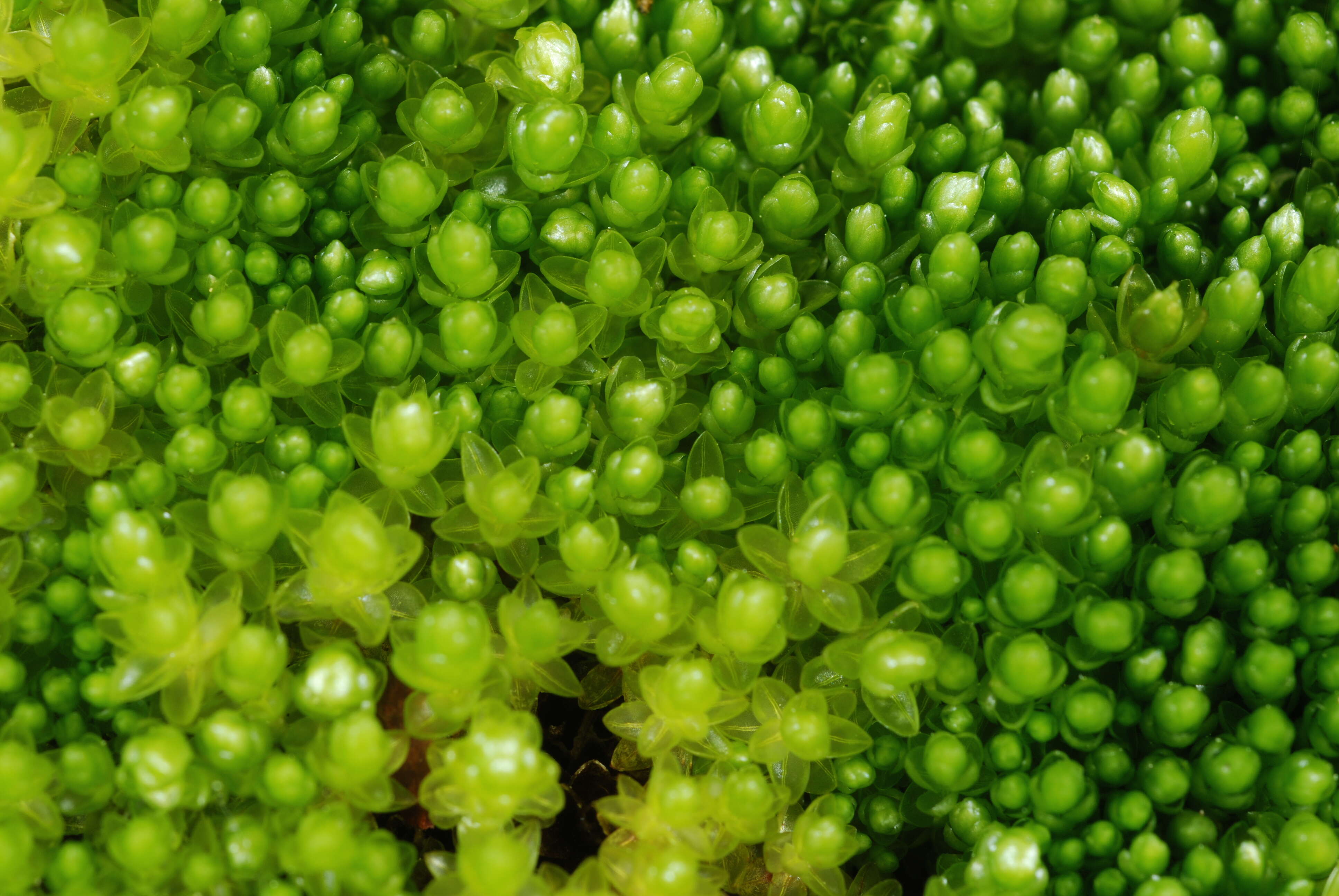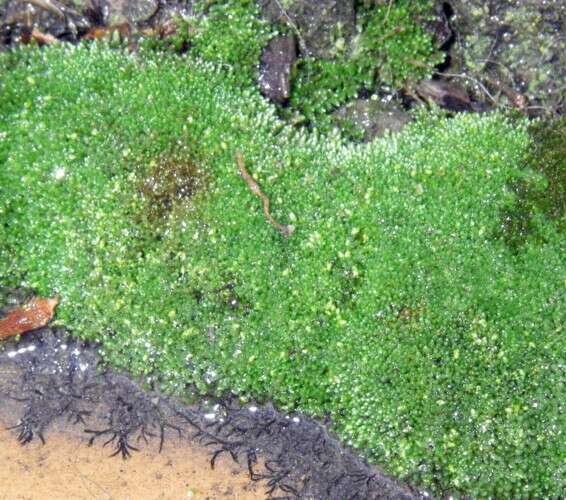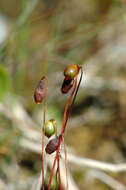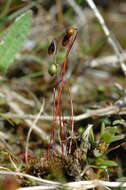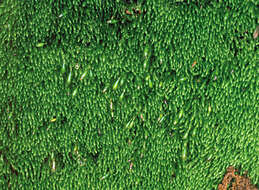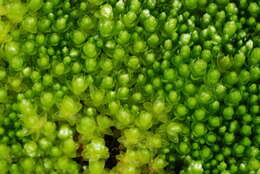-
Schiermonnikoog, Frise, Netherlands
-
Schiermonnikoog, Frise, Netherlands
-
On damp rock at Anderson Springs, Lake County, California, March 25th 2002. Scanned slide 038-007. This is very similar to scanned slide 038-004, posted on Dec. 10th 2011, but has a slightly different colour balance.
-
Tasmania, Australia
-
Tasmania, Australia
-
Oregon City, Oregon, United States
-
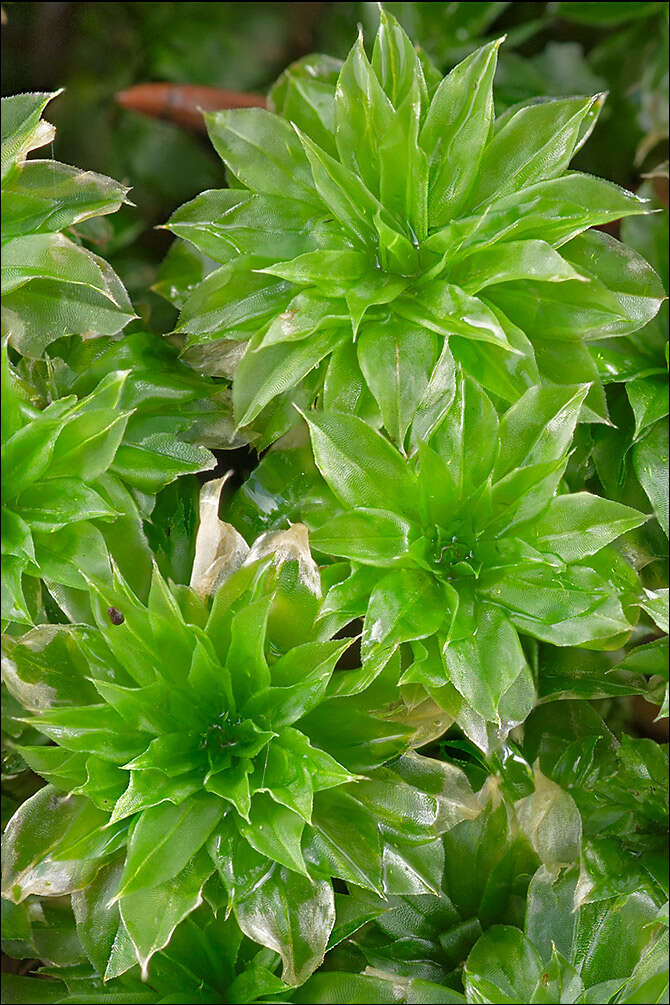
Rhodobryum ontariense (Kindb.) Kindb., syn.: Rhodobryum spathulatum (Hornsch.) PoesEN: Rose-moss, DE: Rosenmoss, Ontario-Rosenmoos, Slo.: ?Dat.: Nov. 9. 2018Lat.: 46,358914 Long.: 13,699772Code: Bot_1162/2018_DSC3920Habitat: Light mixed wood, Fagus sylvatica, Picea abies, Fraxinus ornus, Ostrya carpinifolia dominant trees; slightly inclined mountain slope, south aspect; relatively dry and warm place; in half shade; calcareous, colluvial, skeletal ground; partly protected from direct rain by tree canopies; average precipitations ~ 3.000 mm/year, average temperature 7-9 deg C, elevation 600 m (2.000 feet), alpine phytogeographical region. Substratum: thin soil layer on calcareous rock.Place: Lower Trenta valley, between villages Soa and Trenta, next to the trail from Strgulc abandoned farm house to Trenta 2b cottage, East Julian Alps, Posoje, Slovenia EC. Comment: Rhodobryum ontariense is a very beautiful and quite distinct moss. Its relatively large, terminal 'rosettes' of leaves (more than 1 cm in diameter), which develop on top of short steams resemble green roses (see its names). To recognize genus is not difficult, however, on species level there exist two of them, which are very similar - Rhodobryum ontariense first described in America at the end of 19th century and Rhodobryum roseum first described in Europe approximately at the same time. Later both names have long been considered as synonyms. Rhodobryum roseum has been commonly thought to be a species widely distributed in the temperate and boreal zones of the Northern Hemisphere including Europe, North America, and some areas in Asia. Only in 1972 a thorough revision of the genus (Ref.: 7) separated them again into two species. Rhodobryum ontariense can be distinguished from Rhodobryum roseum by its smaller size (Rhodobryum ontariense is 2 - 3 cm tall and Rhodobryum roseum 5-6(10) cm (Ref.: 3)). The measured height of this find was from 1.5 to 2 cm. The number of leaves in the rosette is another distinguishing trait. Rhodobryum ontariense has 18 -52 leaves in each and Rhodobryum roseum from 16 to 21 leaves. In this find rosettes with more than 40 leaves were frequent. Also preferred substratum and habitat differ. Rhodobryum ontariense prefers dryer places and grows predominantly on calcareous rocks, while Rhodobryum roseum prefers moister places and is found mostly on soil (Ref.: 3). All this speaks in favor of Rhodobryum ontariense. Sporocarps are not distinctive and they anyhow develop very rarely. I haven't seen them yet.Ref.:(1) V. Wirth, R. Dll, Farbatlas Flechten und Moose, Ulmer (2000), p 255.(2) I. Atherton, S. Bosanquet, M. Lawley, eds., Mosses and Liverworts of Britain and Ireland, British Bryological Society, (2010), p 600(3) M. Nebel, G.P hilippi, eds., Die Moose Baden-Wrttembergs, Verlag Eugen Ulmer, Vol: 2. (2001), p 103.(4) W. Rothmaler, Exkursionsflora von Deutschland, Niedere Pflanzen, Band 1, 3.Aufl., Spectrum Akademischer Verlag (2005), p 743.(5)
ohiomosslichen.org/moss-rhodobryum-ontariense/ (accessed Nov. 13. 2018)(6) Z. Iwatsuki and T. Koponen, On the taxonomy and distribution of Rhodobryum roseum and its related species (Bryophyta), Acta Botanica Fennica 96 (1972); accessible at:
scholar.google.si/scholar?q=Iwatsuki+1972+Rhodobryum&... (accessed Nov. 13. 2018)
-

Rhodobryum ontariense (Kindb.) Kindb., syn.: Rhodobryum spathulatum (Hornsch.) PoesEN: Rose-moss, DE: Rosenmoss, Ontario-Rosenmoos, Slo.: ?Dat.: Nov. 9. 2018Lat.: 46,358914 Long.: 13,699772Code: Bot_1162/2018_DSC3920Habitat: Light mixed wood, Fagus sylvatica, Picea abies, Fraxinus ornus, Ostrya carpinifolia dominant trees; slightly inclined mountain slope, south aspect; relatively dry and warm place; in half shade; calcareous, colluvial, skeletal ground; partly protected from direct rain by tree canopies; average precipitations ~ 3.000 mm/year, average temperature 7-9 deg C, elevation 600 m (2.000 feet), alpine phytogeographical region. Substratum: thin soil layer on calcareous rock.Place: Lower Trenta valley, between villages Soa and Trenta, next to the trail from Strgulc abandoned farm house to Trenta 2b cottage, East Julian Alps, Posoje, Slovenia EC. Comment: Rhodobryum ontariense is a very beautiful and quite distinct moss. Its relatively large, terminal 'rosettes' of leaves (more than 1 cm in diameter), which develop on top of short steams resemble green roses (see its names). To recognize genus is not difficult, however, on species level there exist two of them, which are very similar - Rhodobryum ontariense first described in America at the end of 19th century and Rhodobryum roseum first described in Europe approximately at the same time. Later both names have long been considered as synonyms. Rhodobryum roseum has been commonly thought to be a species widely distributed in the temperate and boreal zones of the Northern Hemisphere including Europe, North America, and some areas in Asia. Only in 1972 a thorough revision of the genus (Ref.: 7) separated them again into two species. Rhodobryum ontariense can be distinguished from Rhodobryum roseum by its smaller size (Rhodobryum ontariense is 2 - 3 cm tall and Rhodobryum roseum 5-6(10) cm (Ref.: 3)). The measured height of this find was from 1.5 to 2 cm. The number of leaves in the rosette is another distinguishing trait. Rhodobryum ontariense has 18 -52 leaves in each and Rhodobryum roseum from 16 to 21 leaves. In this find rosettes with more than 40 leaves were frequent. Also preferred substratum and habitat differ. Rhodobryum ontariense prefers dryer places and grows predominantly on calcareous rocks, while Rhodobryum roseum prefers moister places and is found mostly on soil (Ref.: 3). All this speaks in favor of Rhodobryum ontariense. Sporocarps are not distinctive and they anyhow develop very rarely. I haven't seen them yet.Ref.:(1) V. Wirth, R. Dll, Farbatlas Flechten und Moose, Ulmer (2000), p 255.(2) I. Atherton, S. Bosanquet, M. Lawley, eds., Mosses and Liverworts of Britain and Ireland, British Bryological Society, (2010), p 600(3) M. Nebel, G.P hilippi, eds., Die Moose Baden-Wrttembergs, Verlag Eugen Ulmer, Vol: 2. (2001), p 103.(4) W. Rothmaler, Exkursionsflora von Deutschland, Niedere Pflanzen, Band 1, 3.Aufl., Spectrum Akademischer Verlag (2005), p 743.(5)
ohiomosslichen.org/moss-rhodobryum-ontariense/ (accessed Nov. 13. 2018)(6) Z. Iwatsuki and T. Koponen, On the taxonomy and distribution of Rhodobryum roseum and its related species (Bryophyta), Acta Botanica Fennica 96 (1972); accessible at:
scholar.google.si/scholar?q=Iwatsuki+1972+Rhodobryum&... (accessed Nov. 13. 2018)
-

Rhodobryum ontariense (Kindb.) Kindb., syn.: Rhodobryum spathulatum (Hornsch.) PoesEN: Rose-moss, DE: Rosenmoss, Ontario-Rosenmoos, Slo.: ?Dat.: Nov. 9. 2018Lat.: 46,358914 Long.: 13,699772Code: Bot_1162/2018_DSC3920Habitat: Light mixed wood, Fagus sylvatica, Picea abies, Fraxinus ornus, Ostrya carpinifolia dominant trees; slightly inclined mountain slope, south aspect; relatively dry and warm place; in half shade; calcareous, colluvial, skeletal ground; partly protected from direct rain by tree canopies; average precipitations ~ 3.000 mm/year, average temperature 7-9 deg C, elevation 600 m (2.000 feet), alpine phytogeographical region. Substratum: thin soil layer on calcareous rock.Place: Lower Trenta valley, between villages Soa and Trenta, next to the trail from Strgulc abandoned farm house to Trenta 2b cottage, East Julian Alps, Posoje, Slovenia EC. Comment: Rhodobryum ontariense is a very beautiful and quite distinct moss. Its relatively large, terminal 'rosettes' of leaves (more than 1 cm in diameter), which develop on top of short steams resemble green roses (see its names). To recognize genus is not difficult, however, on species level there exist two of them, which are very similar - Rhodobryum ontariense first described in America at the end of 19th century and Rhodobryum roseum first described in Europe approximately at the same time. Later both names have long been considered as synonyms. Rhodobryum roseum has been commonly thought to be a species widely distributed in the temperate and boreal zones of the Northern Hemisphere including Europe, North America, and some areas in Asia. Only in 1972 a thorough revision of the genus (Ref.: 7) separated them again into two species. Rhodobryum ontariense can be distinguished from Rhodobryum roseum by its smaller size (Rhodobryum ontariense is 2 - 3 cm tall and Rhodobryum roseum 5-6(10) cm (Ref.: 3)). The measured height of this find was from 1.5 to 2 cm. The number of leaves in the rosette is another distinguishing trait. Rhodobryum ontariense has 18 -52 leaves in each and Rhodobryum roseum from 16 to 21 leaves. In this find rosettes with more than 40 leaves were frequent. Also preferred substratum and habitat differ. Rhodobryum ontariense prefers dryer places and grows predominantly on calcareous rocks, while Rhodobryum roseum prefers moister places and is found mostly on soil (Ref.: 3). All this speaks in favor of Rhodobryum ontariense. Sporocarps are not distinctive and they anyhow develop very rarely. I haven't seen them yet.Ref.:(1) V. Wirth, R. Dll, Farbatlas Flechten und Moose, Ulmer (2000), p 255.(2) I. Atherton, S. Bosanquet, M. Lawley, eds., Mosses and Liverworts of Britain and Ireland, British Bryological Society, (2010), p 600(3) M. Nebel, G.P hilippi, eds., Die Moose Baden-Wrttembergs, Verlag Eugen Ulmer, Vol: 2. (2001), p 103.(4) W. Rothmaler, Exkursionsflora von Deutschland, Niedere Pflanzen, Band 1, 3.Aufl., Spectrum Akademischer Verlag (2005), p 743.(5)
ohiomosslichen.org/moss-rhodobryum-ontariense/ (accessed Nov. 13. 2018)(6) Z. Iwatsuki and T. Koponen, On the taxonomy and distribution of Rhodobryum roseum and its related species (Bryophyta), Acta Botanica Fennica 96 (1972); accessible at:
scholar.google.si/scholar?q=Iwatsuki+1972+Rhodobryum&... (accessed Nov. 13. 2018)
-
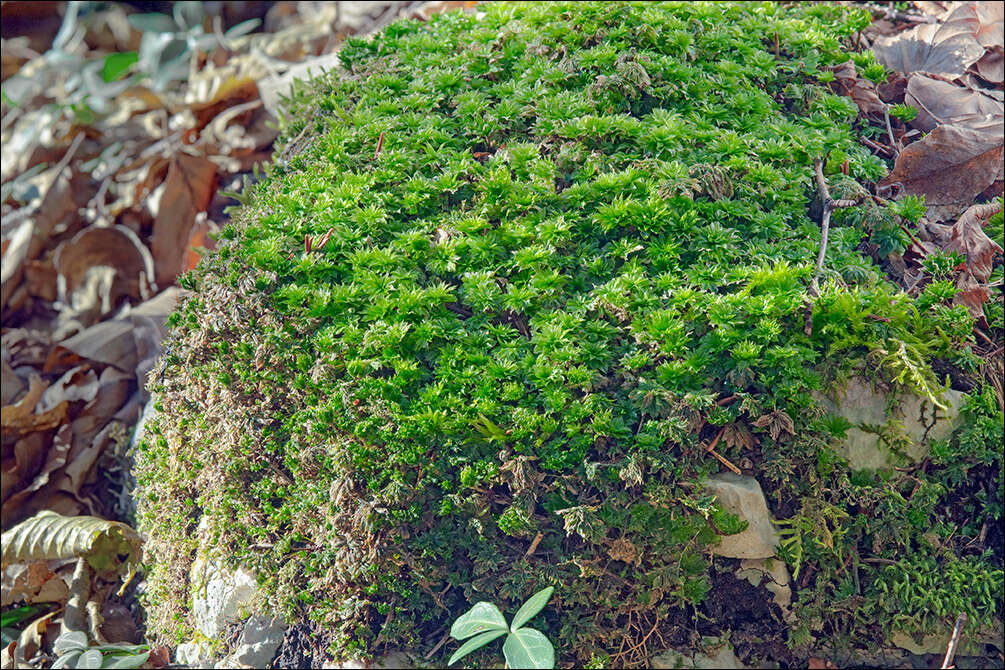
Rhodobryum ontariense (Kindb.) Kindb., syn.: Rhodobryum spathulatum (Hornsch.) PoesEN: Rose-moss, DE: Rosenmoss, Ontario-Rosenmoos, Slo.: ?Dat.: Nov. 9. 2018Lat.: 46,358914 Long.: 13,699772Code: Bot_1162/2018_DSC3920Habitat: Light mixed wood, Fagus sylvatica, Picea abies, Fraxinus ornus, Ostrya carpinifolia dominant trees; slightly inclined mountain slope, south aspect; relatively dry and warm place; in half shade; calcareous, colluvial, skeletal ground; partly protected from direct rain by tree canopies; average precipitations ~ 3.000 mm/year, average temperature 7-9 deg C, elevation 600 m (2.000 feet), alpine phytogeographical region. Substratum: thin soil layer on calcareous rock.Place: Lower Trenta valley, between villages Soa and Trenta, next to the trail from Strgulc abandoned farm house to Trenta 2b cottage, East Julian Alps, Posoje, Slovenia EC. Comment: Rhodobryum ontariense is a very beautiful and quite distinct moss. Its relatively large, terminal 'rosettes' of leaves (more than 1 cm in diameter), which develop on top of short steams resemble green roses (see its names). To recognize genus is not difficult, however, on species level there exist two of them, which are very similar - Rhodobryum ontariense first described in America at the end of 19th century and Rhodobryum roseum first described in Europe approximately at the same time. Later both names have long been considered as synonyms. Rhodobryum roseum has been commonly thought to be a species widely distributed in the temperate and boreal zones of the Northern Hemisphere including Europe, North America, and some areas in Asia. Only in 1972 a thorough revision of the genus (Ref.: 7) separated them again into two species. Rhodobryum ontariense can be distinguished from Rhodobryum roseum by its smaller size (Rhodobryum ontariense is 2 - 3 cm tall and Rhodobryum roseum 5-6(10) cm (Ref.: 3)). The measured height of this find was from 1.5 to 2 cm. The number of leaves in the rosette is another distinguishing trait. Rhodobryum ontariense has 18 -52 leaves in each and Rhodobryum roseum from 16 to 21 leaves. In this find rosettes with more than 40 leaves were frequent. Also preferred substratum and habitat differ. Rhodobryum ontariense prefers dryer places and grows predominantly on calcareous rocks, while Rhodobryum roseum prefers moister places and is found mostly on soil (Ref.: 3). All this speaks in favor of Rhodobryum ontariense. Sporocarps are not distinctive and they anyhow develop very rarely. I haven't seen them yet.Ref.:(1) V. Wirth, R. Dll, Farbatlas Flechten und Moose, Ulmer (2000), p 255.(2) I. Atherton, S. Bosanquet, M. Lawley, eds., Mosses and Liverworts of Britain and Ireland, British Bryological Society, (2010), p 600(3) M. Nebel, G.P hilippi, eds., Die Moose Baden-Wrttembergs, Verlag Eugen Ulmer, Vol: 2. (2001), p 103.(4) W. Rothmaler, Exkursionsflora von Deutschland, Niedere Pflanzen, Band 1, 3.Aufl., Spectrum Akademischer Verlag (2005), p 743.(5)
ohiomosslichen.org/moss-rhodobryum-ontariense/ (accessed Nov. 13. 2018)(6) Z. Iwatsuki and T. Koponen, On the taxonomy and distribution of Rhodobryum roseum and its related species (Bryophyta), Acta Botanica Fennica 96 (1972); accessible at:
scholar.google.si/scholar?q=Iwatsuki+1972+Rhodobryum&... (accessed Nov. 13. 2018)
-

Rhodobryum ontariense (Kindb.) Kindb., syn.: Rhodobryum spathulatum (Hornsch.) PoesEN: Rose-moss, DE: Rosenmoss, Ontario-Rosenmoos, Slo.: ?Dat.: Nov. 9. 2018Lat.: 46,358914 Long.: 13,699772Code: Bot_1162/2018_DSC3920Habitat: Light mixed wood, Fagus sylvatica, Picea abies, Fraxinus ornus, Ostrya carpinifolia dominant trees; slightly inclined mountain slope, south aspect; relatively dry and warm place; in half shade; calcareous, colluvial, skeletal ground; partly protected from direct rain by tree canopies; average precipitations ~ 3.000 mm/year, average temperature 7-9 deg C, elevation 600 m (2.000 feet), alpine phytogeographical region. Substratum: thin soil layer on calcareous rock.Place: Lower Trenta valley, between villages Soa and Trenta, next to the trail from Strgulc abandoned farm house to Trenta 2b cottage, East Julian Alps, Posoje, Slovenia EC. Comment: Rhodobryum ontariense is a very beautiful and quite distinct moss. Its relatively large, terminal 'rosettes' of leaves (more than 1 cm in diameter), which develop on top of short steams resemble green roses (see its names). To recognize genus is not difficult, however, on species level there exist two of them, which are very similar - Rhodobryum ontariense first described in America at the end of 19th century and Rhodobryum roseum first described in Europe approximately at the same time. Later both names have long been considered as synonyms. Rhodobryum roseum has been commonly thought to be a species widely distributed in the temperate and boreal zones of the Northern Hemisphere including Europe, North America, and some areas in Asia. Only in 1972 a thorough revision of the genus (Ref.: 7) separated them again into two species. Rhodobryum ontariense can be distinguished from Rhodobryum roseum by its smaller size (Rhodobryum ontariense is 2 - 3 cm tall and Rhodobryum roseum 5-6(10) cm (Ref.: 3)). The measured height of this find was from 1.5 to 2 cm. The number of leaves in the rosette is another distinguishing trait. Rhodobryum ontariense has 18 -52 leaves in each and Rhodobryum roseum from 16 to 21 leaves. In this find rosettes with more than 40 leaves were frequent. Also preferred substratum and habitat differ. Rhodobryum ontariense prefers dryer places and grows predominantly on calcareous rocks, while Rhodobryum roseum prefers moister places and is found mostly on soil (Ref.: 3). All this speaks in favor of Rhodobryum ontariense. Sporocarps are not distinctive and they anyhow develop very rarely. I haven't seen them yet.Ref.:(1) V. Wirth, R. Dll, Farbatlas Flechten und Moose, Ulmer (2000), p 255.(2) I. Atherton, S. Bosanquet, M. Lawley, eds., Mosses and Liverworts of Britain and Ireland, British Bryological Society, (2010), p 600(3) M. Nebel, G.P hilippi, eds., Die Moose Baden-Wrttembergs, Verlag Eugen Ulmer, Vol: 2. (2001), p 103.(4) W. Rothmaler, Exkursionsflora von Deutschland, Niedere Pflanzen, Band 1, 3.Aufl., Spectrum Akademischer Verlag (2005), p 743.(5)
ohiomosslichen.org/moss-rhodobryum-ontariense/ (accessed Nov. 13. 2018)(6) Z. Iwatsuki and T. Koponen, On the taxonomy and distribution of Rhodobryum roseum and its related species (Bryophyta), Acta Botanica Fennica 96 (1972); accessible at:
scholar.google.si/scholar?q=Iwatsuki+1972+Rhodobryum&... (accessed Nov. 13. 2018)
-

Rhodobryum ontariense (Kindb.) Kindb., syn.: Rhodobryum spathulatum (Hornsch.) PoesEN: Rose-moss, DE: Rosenmoss, Ontario-Rosenmoos, Slo.: ?Dat.: Nov. 9. 2018Lat.: 46,358914 Long.: 13,699772Code: Bot_1162/2018_DSC3920Habitat: Light mixed wood, Fagus sylvatica, Picea abies, Fraxinus ornus, Ostrya carpinifolia dominant trees; slightly inclined mountain slope, south aspect; relatively dry and warm place; in half shade; calcareous, colluvial, skeletal ground; partly protected from direct rain by tree canopies; average precipitations ~ 3.000 mm/year, average temperature 7-9 deg C, elevation 600 m (2.000 feet), alpine phytogeographical region. Substratum: thin soil layer on calcareous rock.Place: Lower Trenta valley, between villages Soa and Trenta, next to the trail from Strgulc abandoned farm house to Trenta 2b cottage, East Julian Alps, Posoje, Slovenia EC. Comment: Rhodobryum ontariense is a very beautiful and quite distinct moss. Its relatively large, terminal 'rosettes' of leaves (more than 1 cm in diameter), which develop on top of short steams resemble green roses (see its names). To recognize genus is not difficult, however, on species level there exist two of them, which are very similar - Rhodobryum ontariense first described in America at the end of 19th century and Rhodobryum roseum first described in Europe approximately at the same time. Later both names have long been considered as synonyms. Rhodobryum roseum has been commonly thought to be a species widely distributed in the temperate and boreal zones of the Northern Hemisphere including Europe, North America, and some areas in Asia. Only in 1972 a thorough revision of the genus (Ref.: 7) separated them again into two species. Rhodobryum ontariense can be distinguished from Rhodobryum roseum by its smaller size (Rhodobryum ontariense is 2 - 3 cm tall and Rhodobryum roseum 5-6(10) cm (Ref.: 3)). The measured height of this find was from 1.5 to 2 cm. The number of leaves in the rosette is another distinguishing trait. Rhodobryum ontariense has 18 -52 leaves in each and Rhodobryum roseum from 16 to 21 leaves. In this find rosettes with more than 40 leaves were frequent. Also preferred substratum and habitat differ. Rhodobryum ontariense prefers dryer places and grows predominantly on calcareous rocks, while Rhodobryum roseum prefers moister places and is found mostly on soil (Ref.: 3). All this speaks in favor of Rhodobryum ontariense. Sporocarps are not distinctive and they anyhow develop very rarely. I haven't seen them yet.Ref.:(1) V. Wirth, R. Dll, Farbatlas Flechten und Moose, Ulmer (2000), p 255.(2) I. Atherton, S. Bosanquet, M. Lawley, eds., Mosses and Liverworts of Britain and Ireland, British Bryological Society, (2010), p 600(3) M. Nebel, G.P hilippi, eds., Die Moose Baden-Wrttembergs, Verlag Eugen Ulmer, Vol: 2. (2001), p 103.(4) W. Rothmaler, Exkursionsflora von Deutschland, Niedere Pflanzen, Band 1, 3.Aufl., Spectrum Akademischer Verlag (2005), p 743.(5)
ohiomosslichen.org/moss-rhodobryum-ontariense/ (accessed Nov. 13. 2018)(6) Z. Iwatsuki and T. Koponen, On the taxonomy and distribution of Rhodobryum roseum and its related species (Bryophyta), Acta Botanica Fennica 96 (1972); accessible at:
scholar.google.si/scholar?q=Iwatsuki+1972+Rhodobryum&... (accessed Nov. 13. 2018)
-
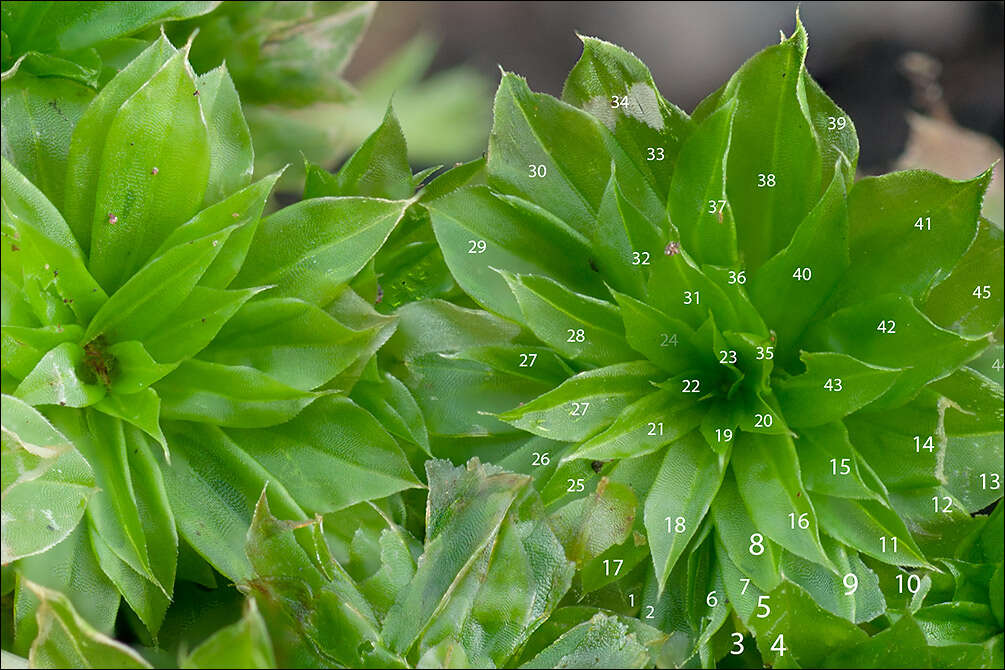
Rhodobryum ontariense (Kindb.) Kindb., syn.: Rhodobryum spathulatum (Hornsch.) PoesEN: Rose-moss, DE: Rosenmoss, Ontario-Rosenmoos, Slo.: ?Dat.: Nov. 9. 2018Lat.: 46,358914 Long.: 13,699772Code: Bot_1162/2018_DSC3920Habitat: Light mixed wood, Fagus sylvatica, Picea abies, Fraxinus ornus, Ostrya carpinifolia dominant trees; slightly inclined mountain slope, south aspect; relatively dry and warm place; in half shade; calcareous, colluvial, skeletal ground; partly protected from direct rain by tree canopies; average precipitations ~ 3.000 mm/year, average temperature 7-9 deg C, elevation 600 m (2.000 feet), alpine phytogeographical region. Substratum: thin soil layer on calcareous rock.Place: Lower Trenta valley, between villages Soa and Trenta, next to the trail from Strgulc abandoned farm house to Trenta 2b cottage, East Julian Alps, Posoje, Slovenia EC. Comment: Rhodobryum ontariense is a very beautiful and quite distinct moss. Its relatively large, terminal 'rosettes' of leaves (more than 1 cm in diameter), which develop on top of short steams resemble green roses (see its names). To recognize genus is not difficult, however, on species level there exist two of them, which are very similar - Rhodobryum ontariense first described in America at the end of 19th century and Rhodobryum roseum first described in Europe approximately at the same time. Later both names have long been considered as synonyms. Rhodobryum roseum has been commonly thought to be a species widely distributed in the temperate and boreal zones of the Northern Hemisphere including Europe, North America, and some areas in Asia. Only in 1972 a thorough revision of the genus (Ref.: 7) separated them again into two species. Rhodobryum ontariense can be distinguished from Rhodobryum roseum by its smaller size (Rhodobryum ontariense is 2 - 3 cm tall and Rhodobryum roseum 5-6(10) cm (Ref.: 3)). The measured height of this find was from 1.5 to 2 cm. The number of leaves in the rosette is another distinguishing trait. Rhodobryum ontariense has 18 -52 leaves in each and Rhodobryum roseum from 16 to 21 leaves. In this find rosettes with more than 40 leaves were frequent. Also preferred substratum and habitat differ. Rhodobryum ontariense prefers dryer places and grows predominantly on calcareous rocks, while Rhodobryum roseum prefers moister places and is found mostly on soil (Ref.: 3). All this speaks in favor of Rhodobryum ontariense. Sporocarps are not distinctive and they anyhow develop very rarely. I haven't seen them yet.Ref.:(1) V. Wirth, R. Dll, Farbatlas Flechten und Moose, Ulmer (2000), p 255.(2) I. Atherton, S. Bosanquet, M. Lawley, eds., Mosses and Liverworts of Britain and Ireland, British Bryological Society, (2010), p 600(3) M. Nebel, G.P hilippi, eds., Die Moose Baden-Wrttembergs, Verlag Eugen Ulmer, Vol: 2. (2001), p 103.(4) W. Rothmaler, Exkursionsflora von Deutschland, Niedere Pflanzen, Band 1, 3.Aufl., Spectrum Akademischer Verlag (2005), p 743.(5)
ohiomosslichen.org/moss-rhodobryum-ontariense/ (accessed Nov. 13. 2018)(6) Z. Iwatsuki and T. Koponen, On the taxonomy and distribution of Rhodobryum roseum and its related species (Bryophyta), Acta Botanica Fennica 96 (1972); accessible at:
scholar.google.si/scholar?q=Iwatsuki+1972+Rhodobryum&... (accessed Nov. 13. 2018)
-
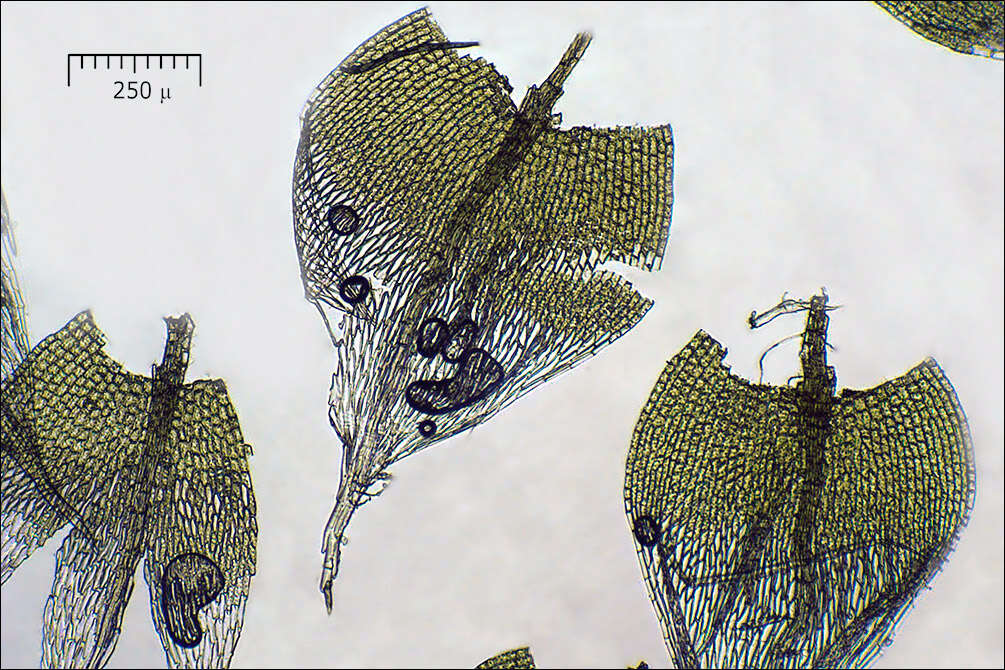
Bryum argenteum Hewdw.Family: BryaceaeEN: Silvergreen Bryum Moss, DE: Silber-Birnmoos, SilbermoosSlo.: srebrna hruica, srebrnkasto mahovjeDat.: March 16. and March 17. 2022Lat.: 46.35976 Long.: 13.70495Code: Bot_1442/2022_DSC6214 and Bot_1443/2022_DSC6298Habitat: Dry, former pasture near an abandoned farm house, semiruderal, skeletal, calcareous ground; dry, mostly sunny, open place; exposed to direct rain, average precipitations ~ 3.000 mm/year, average temperature 7-9 deg C, elevations 553 m (1.800 feet), alpine phytogeographical region. Substratum: shallow, sandy, poor soil. Place: Lower Trenta valley, between villages Soa and Trenta, right bank of river Soa, next to Skokar farmhouse, Trenta 2, East Julian Alps, Posoje, Slovenia EC. Comments (pertain to pictures in Flicker album Bryum argenteum): Bryum argenteum is a common and cosmopolitan moss (absent only from Antarctica). It can be easily recognized by its typical growth: cylindrical shoots about 1 cm or less long with adpressed leaves grow in usually compact, low cushions or mats sometimes of considerable size. They have a characteristic silvery-whitish appearance particularly if dry. This I due to the fact that the cells of the upper part of the leaves lack chlorophyll, hence the shots look greenish silvery-whitish (see Fig. 2M). The moss frequently grows in anthropogenic habitats and on disturbed ground, but also in the wild in many different habitats like on poor soils, and rocks. Ref.:(1) Ian Atherton, Ed., Mosses and Liverworts of Britain and Ireland - a field guide, British Bryological Society (2010), p 596. (2) M. Lth, Mosses of Europe A Photographic Flora, Michael Lth, Vol. 3., 2019, p 877.(3) M. Nebel, G. Philippi, eds., Die Mosse Baden-Wurttembergs, Band 2., (2002), Ulmer, p 55. (4) V. Wirth, R. Duell, Farbatlas Flechten und Moose, Ulmer, (2000), p 253.
-
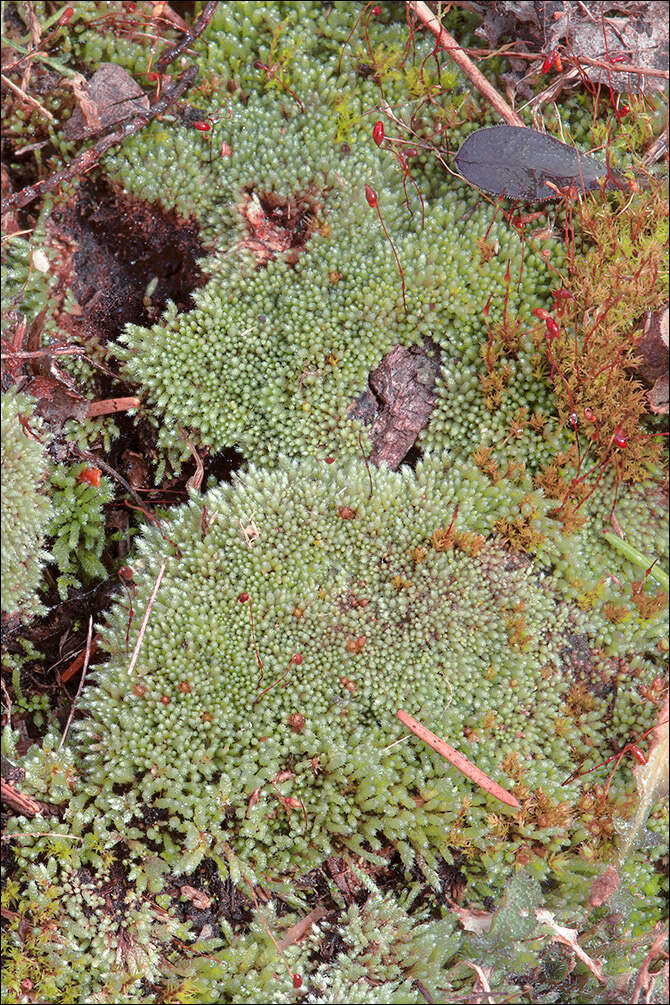
Bryum argenteum Hewdw.Family: BryaceaeEN: Silvergreen Bryum Moss, DE: Silber-Birnmoos, SilbermoosSlo.: srebrna hruica, srebrnkasto mahovjeDat.: March 16. and March 17. 2022Lat.: 46.35976 Long.: 13.70495Code: Bot_1442/2022_DSC6214 and Bot_1443/2022_DSC6298Habitat: Dry, former pasture near an abandoned farm house, semiruderal, skeletal, calcareous ground; dry, mostly sunny, open place; exposed to direct rain, average precipitations ~ 3.000 mm/year, average temperature 7-9 deg C, elevations 553 m (1.800 feet), alpine phytogeographical region. Substratum: shallow, sandy, poor soil. Place: Lower Trenta valley, between villages Soa and Trenta, right bank of river Soa, next to Skokar farmhouse, Trenta 2, East Julian Alps, Posoje, Slovenia EC. Comments (pertain to pictures in Flicker album Bryum argenteum): Bryum argenteum is a common and cosmopolitan moss (absent only from Antarctica). It can be easily recognized by its typical growth: cylindrical shoots about 1 cm or less long with adpressed leaves grow in usually compact, low cushions or mats sometimes of considerable size. They have a characteristic silvery-whitish appearance particularly if dry. This I due to the fact that the cells of the upper part of the leaves lack chlorophyll, hence the shots look greenish silvery-whitish (see Fig. 2M). The moss frequently grows in anthropogenic habitats and on disturbed ground, but also in the wild in many different habitats like on poor soils, and rocks. Ref.:(1) Ian Atherton, Ed., Mosses and Liverworts of Britain and Ireland - a field guide, British Bryological Society (2010), p 596. (2) M. Lth, Mosses of Europe A Photographic Flora, Michael Lth, Vol. 3., 2019, p 877.(3) M. Nebel, G. Philippi, eds., Die Mosse Baden-Wurttembergs, Band 2., (2002), Ulmer, p 55. (4) V. Wirth, R. Duell, Farbatlas Flechten und Moose, Ulmer, (2000), p 253.
-
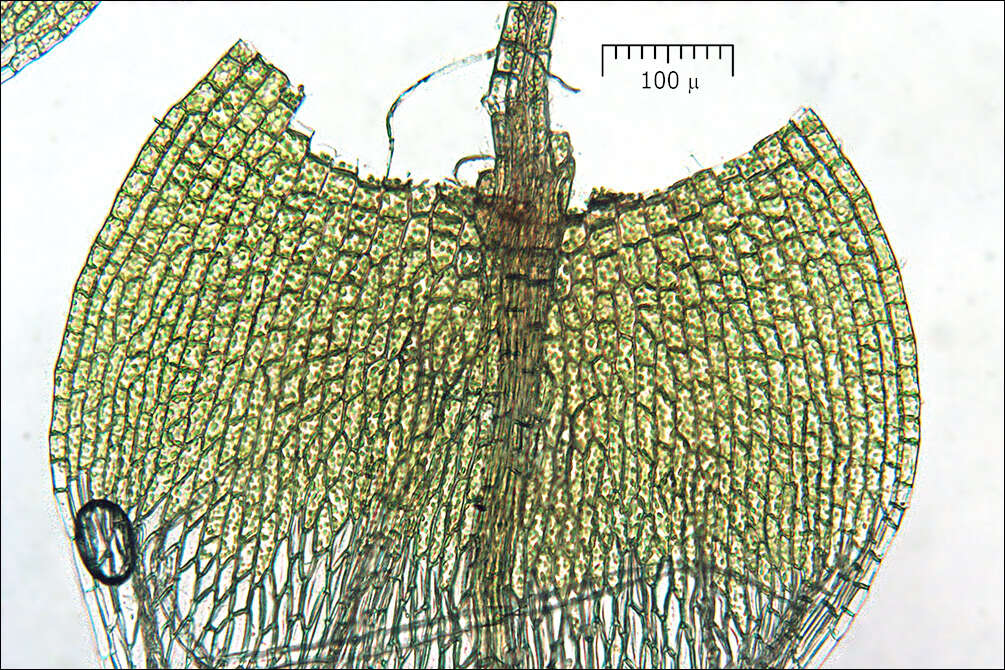
Bryum argenteum Hewdw.Family: BryaceaeEN: Silvergreen Bryum Moss, DE: Silber-Birnmoos, SilbermoosSlo.: srebrna hruica, srebrnkasto mahovjeDat.: March 16. and March 17. 2022Lat.: 46.35976 Long.: 13.70495Code: Bot_1442/2022_DSC6214 and Bot_1443/2022_DSC6298Habitat: Dry, former pasture near an abandoned farm house, semiruderal, skeletal, calcareous ground; dry, mostly sunny, open place; exposed to direct rain, average precipitations ~ 3.000 mm/year, average temperature 7-9 deg C, elevations 553 m (1.800 feet), alpine phytogeographical region. Substratum: shallow, sandy, poor soil. Place: Lower Trenta valley, between villages Soa and Trenta, right bank of river Soa, next to Skokar farmhouse, Trenta 2, East Julian Alps, Posoje, Slovenia EC. Comments (pertain to pictures in Flicker album Bryum argenteum): Bryum argenteum is a common and cosmopolitan moss (absent only from Antarctica). It can be easily recognized by its typical growth: cylindrical shoots about 1 cm or less long with adpressed leaves grow in usually compact, low cushions or mats sometimes of considerable size. They have a characteristic silvery-whitish appearance particularly if dry. This I due to the fact that the cells of the upper part of the leaves lack chlorophyll, hence the shots look greenish silvery-whitish (see Fig. 2M). The moss frequently grows in anthropogenic habitats and on disturbed ground, but also in the wild in many different habitats like on poor soils, and rocks. Ref.:(1) Ian Atherton, Ed., Mosses and Liverworts of Britain and Ireland - a field guide, British Bryological Society (2010), p 596. (2) M. Lth, Mosses of Europe A Photographic Flora, Michael Lth, Vol. 3., 2019, p 877.(3) M. Nebel, G. Philippi, eds., Die Mosse Baden-Wurttembergs, Band 2., (2002), Ulmer, p 55. (4) V. Wirth, R. Duell, Farbatlas Flechten und Moose, Ulmer, (2000), p 253.
-
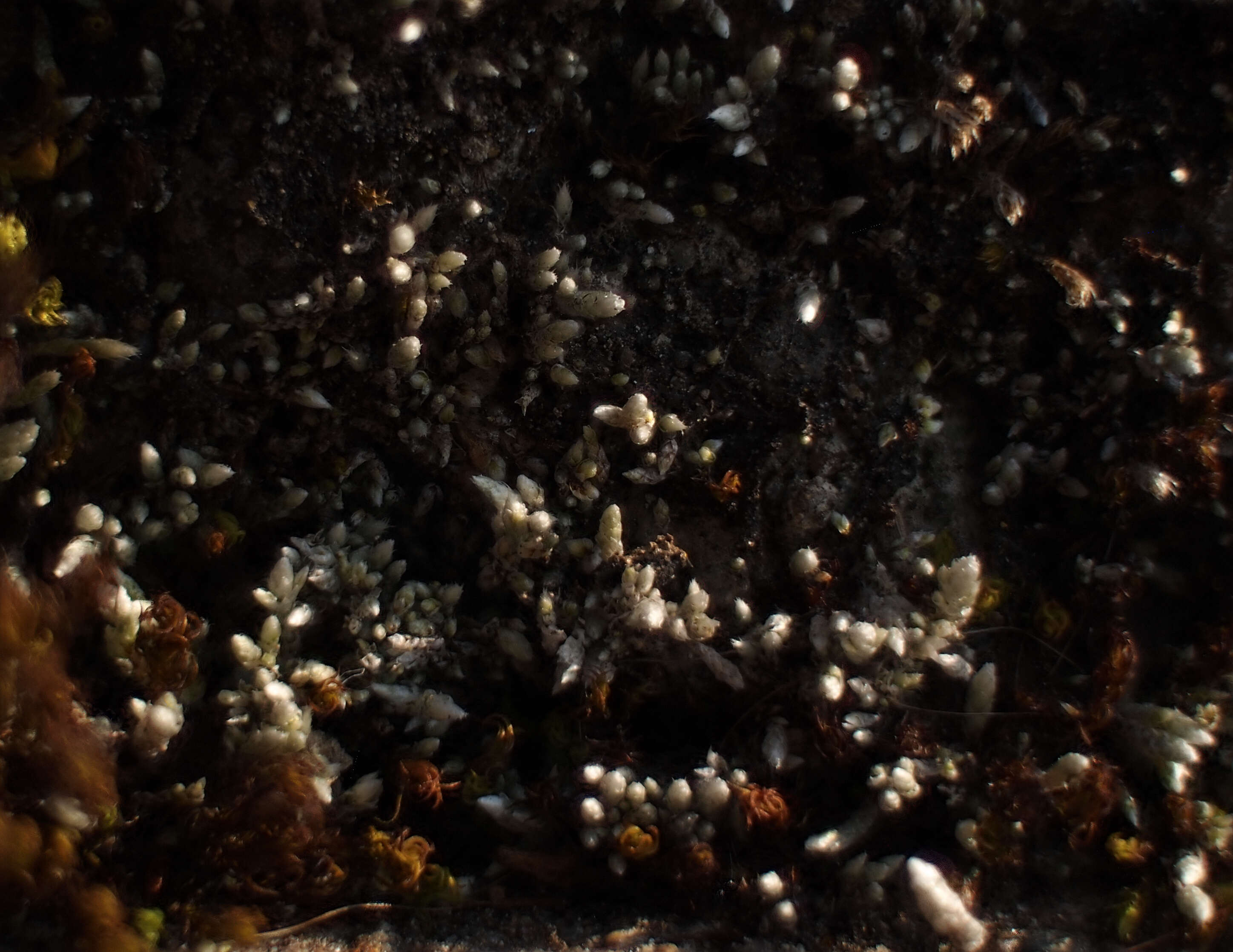
Bryum argenteum growing on retaining wall built of concrete blocks. As you can see, this nice silver-green moss turns completely white when dry (wall looks West and receives enough sun to be completely dry). This photo was taken as stack of 11 frames using tripod and my DIY translation stage. Lens - 20mm Panasonic prime, attached to camera via Kenko extension ring.I'm pretty happy with result - it's my first stack taken outdoors with this setup, and I'm still concerned about lousy cheap Vanguard ballhead (which is as part of kit with my carbon fiber tripod). But tightening the locking knob with pliers helps to get enough friction.All the processing performed in ImageJ 2, using Linear SIFT-based registration and Extended Depth of Field plugin. Some ripple, visible around brightest points, is pretty subtle, so I'm happy with choice of settings (exposure time, mainly). It's easy to avoid situations like that using diffuser to remove direct light and lower the contrast, fitting it into dynamic range of camera.
-
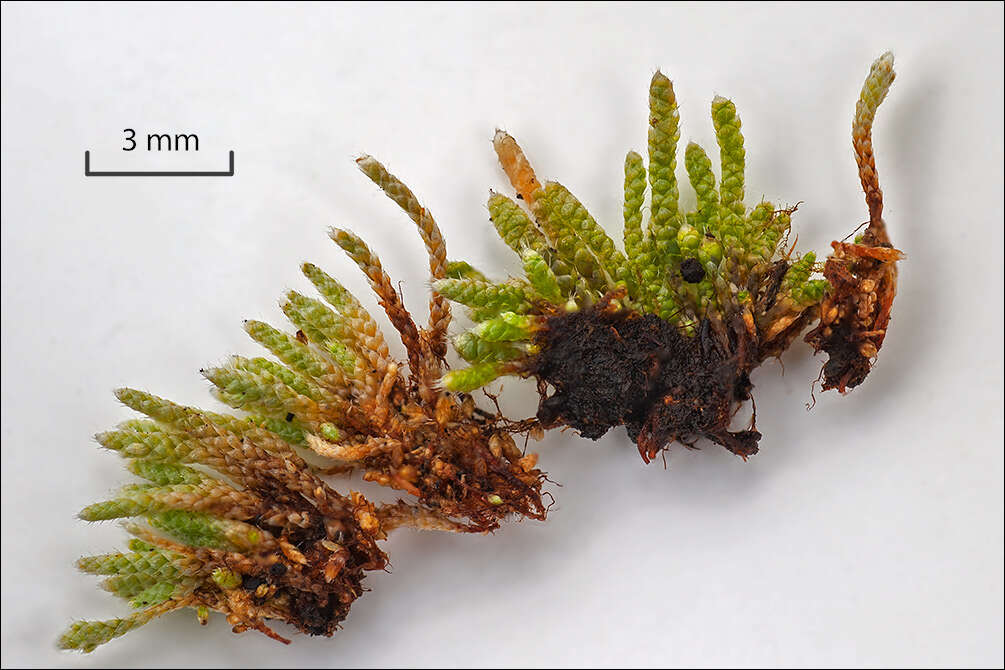
Bryum argenteum Hewdw.Family: BryaceaeEN: Silvergreen Bryum Moss, DE: Silber-Birnmoos, SilbermoosSlo.: srebrna hruica, srebrnkasto mahovjeDat.: March 16. and March 17. 2022Lat.: 46.35976 Long.: 13.70495Code: Bot_1442/2022_DSC6214 and Bot_1443/2022_DSC6298Habitat: Dry, former pasture near an abandoned farm house, semiruderal, skeletal, calcareous ground; dry, mostly sunny, open place; exposed to direct rain, average precipitations ~ 3.000 mm/year, average temperature 7-9 deg C, elevations 553 m (1.800 feet), alpine phytogeographical region. Substratum: shallow, sandy, poor soil. Place: Lower Trenta valley, between villages Soa and Trenta, right bank of river Soa, next to Skokar farmhouse, Trenta 2, East Julian Alps, Posoje, Slovenia EC. Comments (pertain to pictures in Flicker album Bryum argenteum): Bryum argenteum is a common and cosmopolitan moss (absent only from Antarctica). It can be easily recognized by its typical growth: cylindrical shoots about 1 cm or less long with adpressed leaves grow in usually compact, low cushions or mats sometimes of considerable size. They have a characteristic silvery-whitish appearance particularly if dry. This I due to the fact that the cells of the upper part of the leaves lack chlorophyll, hence the shots look greenish silvery-whitish (see Fig. 2M). The moss frequently grows in anthropogenic habitats and on disturbed ground, but also in the wild in many different habitats like on poor soils, and rocks. Ref.:(1) Ian Atherton, Ed., Mosses and Liverworts of Britain and Ireland - a field guide, British Bryological Society (2010), p 596. (2) M. Lth, Mosses of Europe A Photographic Flora, Michael Lth, Vol. 3., 2019, p 877.(3) M. Nebel, G. Philippi, eds., Die Mosse Baden-Wurttembergs, Band 2., (2002), Ulmer, p 55. (4) V. Wirth, R. Duell, Farbatlas Flechten und Moose, Ulmer, (2000), p 253.
-
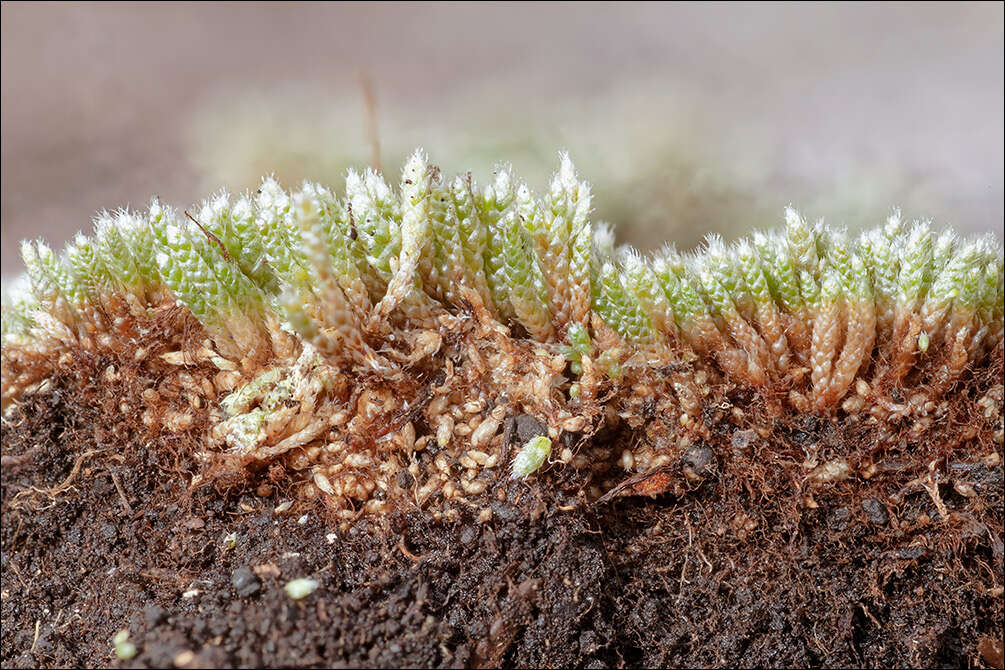
Bryum argenteum Hewdw.Family: BryaceaeEN: Silvergreen Bryum Moss, DE: Silber-Birnmoos, SilbermoosSlo.: srebrna hruica, srebrnkasto mahovjeDat.: March 16. and March 17. 2022Lat.: 46.35976 Long.: 13.70495Code: Bot_1442/2022_DSC6214 and Bot_1443/2022_DSC6298Habitat: Dry, former pasture near an abandoned farm house, semiruderal, skeletal, calcareous ground; dry, mostly sunny, open place; exposed to direct rain, average precipitations ~ 3.000 mm/year, average temperature 7-9 deg C, elevations 553 m (1.800 feet), alpine phytogeographical region. Substratum: shallow, sandy, poor soil. Place: Lower Trenta valley, between villages Soa and Trenta, right bank of river Soa, next to Skokar farmhouse, Trenta 2, East Julian Alps, Posoje, Slovenia EC. Comments (pertain to pictures in Flicker album Bryum argenteum): Bryum argenteum is a common and cosmopolitan moss (absent only from Antarctica). It can be easily recognized by its typical growth: cylindrical shoots about 1 cm or less long with adpressed leaves grow in usually compact, low cushions or mats sometimes of considerable size. They have a characteristic silvery-whitish appearance particularly if dry. This I due to the fact that the cells of the upper part of the leaves lack chlorophyll, hence the shots look greenish silvery-whitish (see Fig. 2M). The moss frequently grows in anthropogenic habitats and on disturbed ground, but also in the wild in many different habitats like on poor soils, and rocks. Ref.:(1) Ian Atherton, Ed., Mosses and Liverworts of Britain and Ireland - a field guide, British Bryological Society (2010), p 596. (2) M. Lth, Mosses of Europe A Photographic Flora, Michael Lth, Vol. 3., 2019, p 877.(3) M. Nebel, G. Philippi, eds., Die Mosse Baden-Wurttembergs, Band 2., (2002), Ulmer, p 55. (4) V. Wirth, R. Duell, Farbatlas Flechten und Moose, Ulmer, (2000), p 253.
-
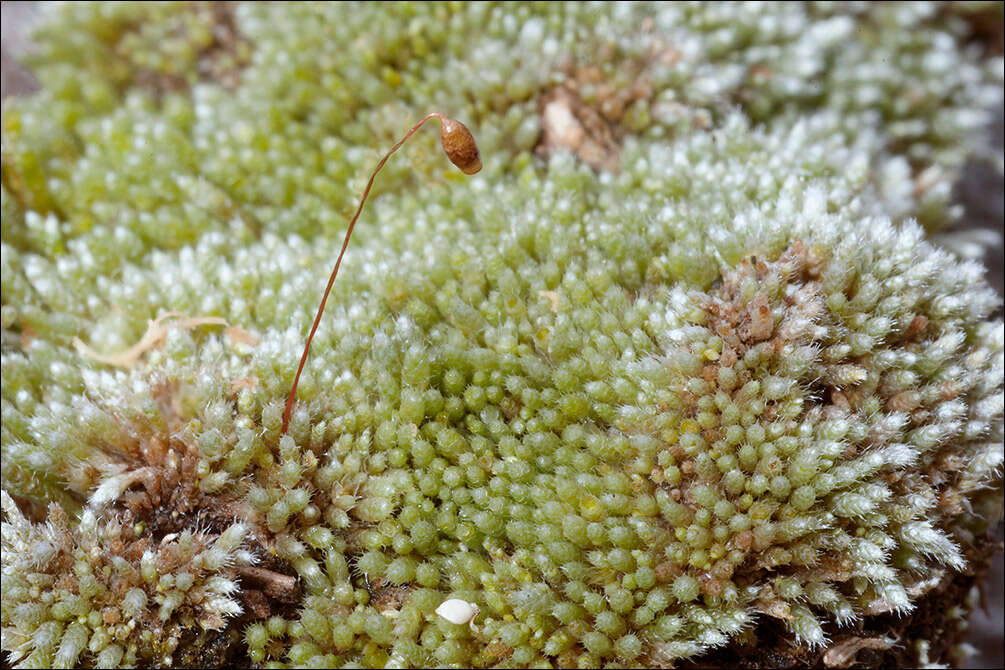
Bryum argenteum Hewdw.Family: BryaceaeEN: Silvergreen Bryum Moss, DE: Silber-Birnmoos, SilbermoosSlo.: srebrna hruica, srebrnkasto mahovjeDat.: March 16. and March 17. 2022Lat.: 46.35976 Long.: 13.70495Code: Bot_1442/2022_DSC6214 and Bot_1443/2022_DSC6298Habitat: Dry, former pasture near an abandoned farm house, semiruderal, skeletal, calcareous ground; dry, mostly sunny, open place; exposed to direct rain, average precipitations ~ 3.000 mm/year, average temperature 7-9 deg C, elevations 553 m (1.800 feet), alpine phytogeographical region. Substratum: shallow, sandy, poor soil. Place: Lower Trenta valley, between villages Soa and Trenta, right bank of river Soa, next to Skokar farmhouse, Trenta 2, East Julian Alps, Posoje, Slovenia EC. Comments (pertain to pictures in Flicker album Bryum argenteum): Bryum argenteum is a common and cosmopolitan moss (absent only from Antarctica). It can be easily recognized by its typical growth: cylindrical shoots about 1 cm or less long with adpressed leaves grow in usually compact, low cushions or mats sometimes of considerable size. They have a characteristic silvery-whitish appearance particularly if dry. This I due to the fact that the cells of the upper part of the leaves lack chlorophyll, hence the shots look greenish silvery-whitish (see Fig. 2M). The moss frequently grows in anthropogenic habitats and on disturbed ground, but also in the wild in many different habitats like on poor soils, and rocks. Ref.:(1) Ian Atherton, Ed., Mosses and Liverworts of Britain and Ireland - a field guide, British Bryological Society (2010), p 596. (2) M. Lth, Mosses of Europe A Photographic Flora, Michael Lth, Vol. 3., 2019, p 877.(3) M. Nebel, G. Philippi, eds., Die Mosse Baden-Wurttembergs, Band 2., (2002), Ulmer, p 55. (4) V. Wirth, R. Duell, Farbatlas Flechten und Moose, Ulmer, (2000), p 253.
-
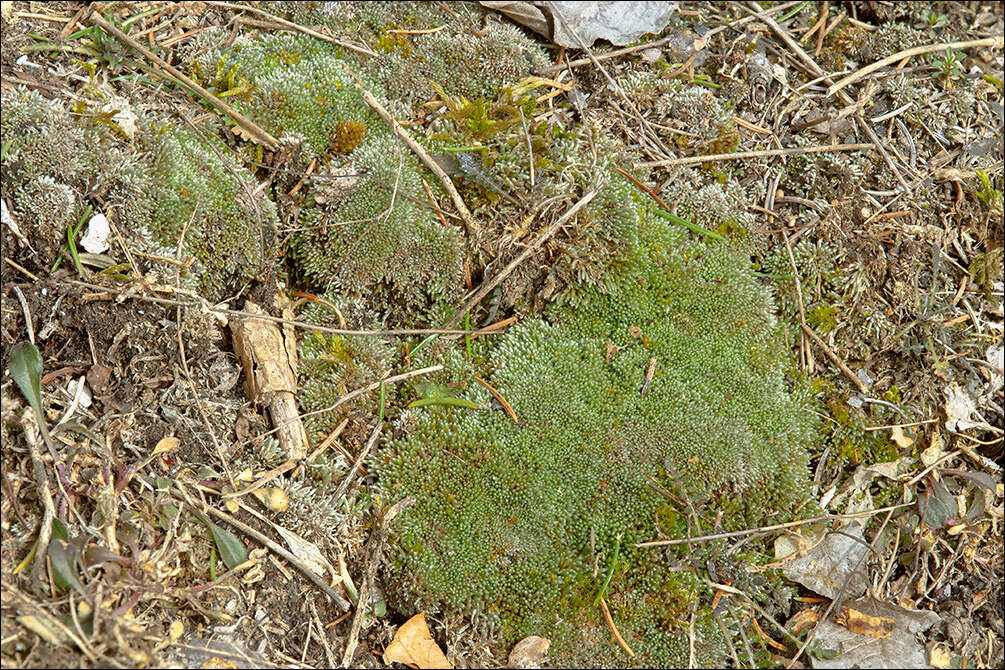
Bryum argenteum Hewdw.Family: BryaceaeEN: Silvergreen Bryum Moss, DE: Silber-Birnmoos, SilbermoosSlo.: srebrna hruica, srebrnkasto mahovjeDat.: March 16. and March 17. 2022Lat.: 46.35976 Long.: 13.70495Code: Bot_1442/2022_DSC6214 and Bot_1443/2022_DSC6298Habitat: Dry, former pasture near an abandoned farm house, semiruderal, skeletal, calcareous ground; dry, mostly sunny, open place; exposed to direct rain, average precipitations ~ 3.000 mm/year, average temperature 7-9 deg C, elevations 553 m (1.800 feet), alpine phytogeographical region. Substratum: shallow, sandy, poor soil. Place: Lower Trenta valley, between villages Soa and Trenta, right bank of river Soa, next to Skokar farmhouse, Trenta 2, East Julian Alps, Posoje, Slovenia EC. Comments (pertain to pictures in Flicker album Bryum argenteum): Bryum argenteum is a common and cosmopolitan moss (absent only from Antarctica). It can be easily recognized by its typical growth: cylindrical shoots about 1 cm or less long with adpressed leaves grow in usually compact, low cushions or mats sometimes of considerable size. They have a characteristic silvery-whitish appearance particularly if dry. This I due to the fact that the cells of the upper part of the leaves lack chlorophyll, hence the shots look greenish silvery-whitish (see Fig. 2M). The moss frequently grows in anthropogenic habitats and on disturbed ground, but also in the wild in many different habitats like on poor soils, and rocks. Ref.:(1) Ian Atherton, Ed., Mosses and Liverworts of Britain and Ireland - a field guide, British Bryological Society (2010), p 596. (2) M. Lth, Mosses of Europe A Photographic Flora, Michael Lth, Vol. 3., 2019, p 877.(3) M. Nebel, G. Philippi, eds., Die Mosse Baden-Wurttembergs, Band 2., (2002), Ulmer, p 55. (4) V. Wirth, R. Duell, Farbatlas Flechten und Moose, Ulmer, (2000), p 253.
-
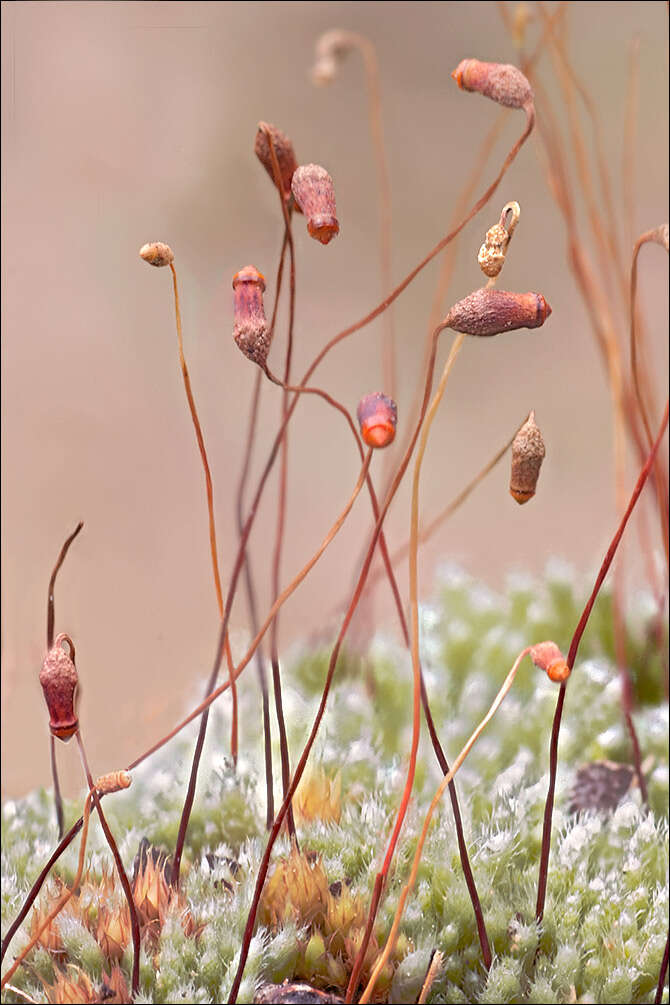
Bryum argenteum Hewdw.Family: BryaceaeEN: Silvergreen Bryum Moss, DE: Silber-Birnmoos, SilbermoosSlo.: srebrna hruica, srebrnkasto mahovjeDat.: March 16. and March 17. 2022Lat.: 46.35976 Long.: 13.70495Code: Bot_1442/2022_DSC6214 and Bot_1443/2022_DSC6298Habitat: Dry, former pasture near an abandoned farm house, semiruderal, skeletal, calcareous ground; dry, mostly sunny, open place; exposed to direct rain, average precipitations ~ 3.000 mm/year, average temperature 7-9 deg C, elevations 553 m (1.800 feet), alpine phytogeographical region. Substratum: shallow, sandy, poor soil. Place: Lower Trenta valley, between villages Soa and Trenta, right bank of river Soa, next to Skokar farmhouse, Trenta 2, East Julian Alps, Posoje, Slovenia EC. Comments (pertain to pictures in Flicker album Bryum argenteum): Bryum argenteum is a common and cosmopolitan moss (absent only from Antarctica). It can be easily recognized by its typical growth: cylindrical shoots about 1 cm or less long with adpressed leaves grow in usually compact, low cushions or mats sometimes of considerable size. They have a characteristic silvery-whitish appearance particularly if dry. This I due to the fact that the cells of the upper part of the leaves lack chlorophyll, hence the shots look greenish silvery-whitish (see Fig. 2M). The moss frequently grows in anthropogenic habitats and on disturbed ground, but also in the wild in many different habitats like on poor soils, and rocks. Ref.:(1) Ian Atherton, Ed., Mosses and Liverworts of Britain and Ireland - a field guide, British Bryological Society (2010), p 596. (2) M. Lth, Mosses of Europe A Photographic Flora, Michael Lth, Vol. 3., 2019, p 877.(3) M. Nebel, G. Philippi, eds., Die Mosse Baden-Wurttembergs, Band 2., (2002), Ulmer, p 55. (4) V. Wirth, R. Duell, Farbatlas Flechten und Moose, Ulmer, (2000), p 253.
-
-
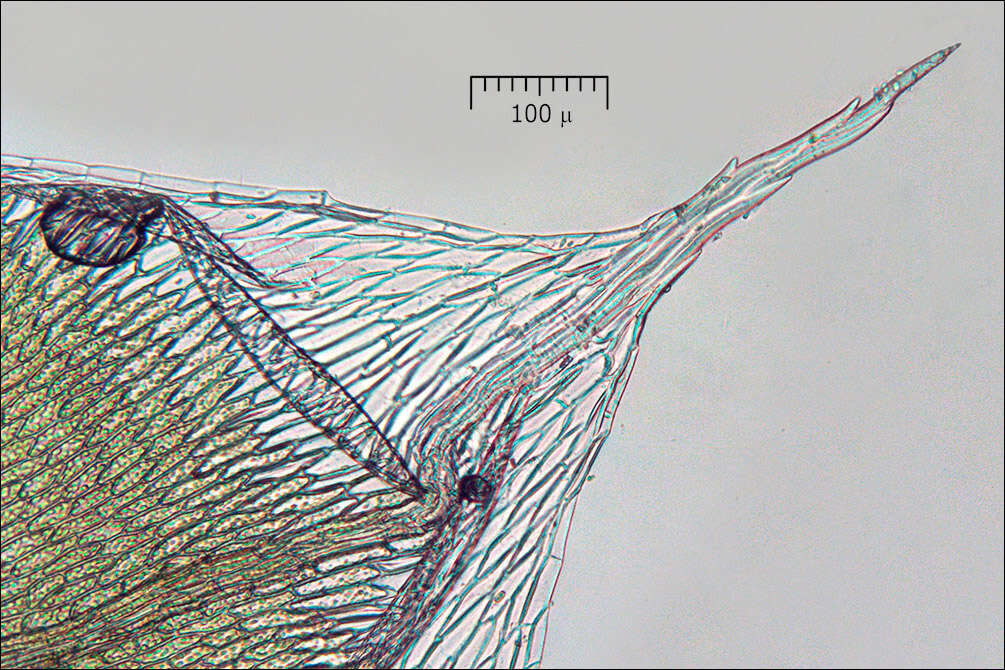
Bryum argenteum Hewdw.Family: BryaceaeEN: Silvergreen Bryum Moss, DE: Silber-Birnmoos, SilbermoosSlo.: srebrna hruica, srebrnkasto mahovjeDat.: March 16. and March 17. 2022Lat.: 46.35976 Long.: 13.70495Code: Bot_1442/2022_DSC6214 and Bot_1443/2022_DSC6298Habitat: Dry, former pasture near an abandoned farm house, semiruderal, skeletal, calcareous ground; dry, mostly sunny, open place; exposed to direct rain, average precipitations ~ 3.000 mm/year, average temperature 7-9 deg C, elevations 553 m (1.800 feet), alpine phytogeographical region. Substratum: shallow, sandy, poor soil. Place: Lower Trenta valley, between villages Soa and Trenta, right bank of river Soa, next to Skokar farmhouse, Trenta 2, East Julian Alps, Posoje, Slovenia EC. Comments (pertain to pictures in Flicker album Bryum argenteum): Bryum argenteum is a common and cosmopolitan moss (absent only from Antarctica). It can be easily recognized by its typical growth: cylindrical shoots about 1 cm or less long with adpressed leaves grow in usually compact, low cushions or mats sometimes of considerable size. They have a characteristic silvery-whitish appearance particularly if dry. This I due to the fact that the cells of the upper part of the leaves lack chlorophyll, hence the shots look greenish silvery-whitish (see Fig. 2M). The moss frequently grows in anthropogenic habitats and on disturbed ground, but also in the wild in many different habitats like on poor soils, and rocks. Ref.:(1) Ian Atherton, Ed., Mosses and Liverworts of Britain and Ireland - a field guide, British Bryological Society (2010), p 596. (2) M. Lth, Mosses of Europe A Photographic Flora, Michael Lth, Vol. 3., 2019, p 877.(3) M. Nebel, G. Philippi, eds., Die Mosse Baden-Wurttembergs, Band 2., (2002), Ulmer, p 55. (4) V. Wirth, R. Duell, Farbatlas Flechten und Moose, Ulmer, (2000), p 253.





